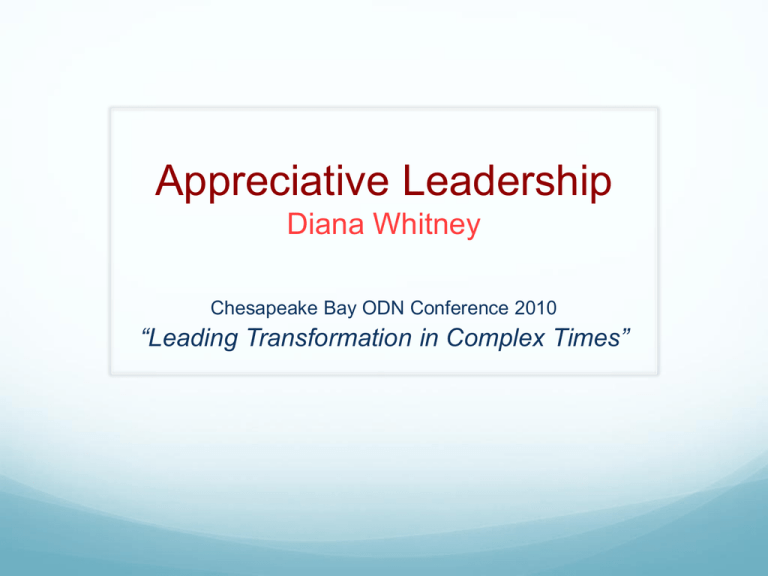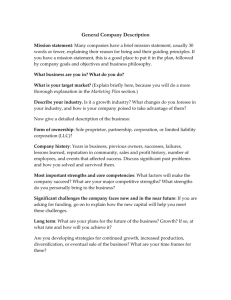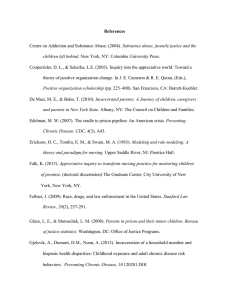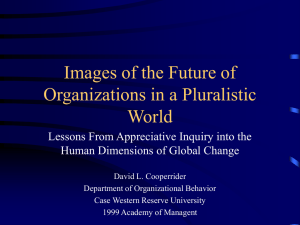The Wisdom of Positive Performance
advertisement

Appreciative Leadership Diana Whitney Chesapeake Bay ODN Conference 2010 “Leading Transformation in Complex Times” An Invitation to A Positive Revolution Positive Organizational Appreciative Inquiry Scholarship Asset Based Development Positive Deviancy Positive Psychology Strengths Movement (c) Corporation for Positive Change Solution Based Therapy Creation Spirituality 2 Five Strategies of Appreciative Leadership The Wisdom of INQUIRY The Genius of INCLUSION The Art of ILLUMINATION The Courage of INSPIRATION The Path of INTEGRITY Appreciative Leadership (c) Corporation for Positive Change Whitney, Trosten-Bloom, Rader 3 1. The Wisdom of Inquiry Asking Positively Powerful Questions “Tell me about the river that connects you.” Appreciative Leadership (c) Corporation for Positive Change Whitney, Trosten-Bloom, Rader 4 The Case of BP PROCARE Survey Results showed 79% Customer Satisfaction Desired to improve Conducted Focus Groups Dissatisfied Customers Asked: What are we doing wrong? Shared the information widely The bottom drops out... (c) Corporation for Positive Change 5 The Appreciative Alternative A Root Cause of Success Analysis Study of Outstanding Customer Satisfaction Interviews with All Customers What attracted you to us initially? Your best experience with us? What made it satisfying? Generative Benchmarking 8 months - 95% Fully Satisfied What did they learn? (c) Corporation for Positive Change 6 What is Appreciative Inquiry? The study of what gives life to human systems – people, teams, organizations, processes – when they are at our best. Appreciation = valuing, prizing, affirming, honoring, recognizing the best of people and situations. Inquiry = exploration, discovery, asking, being open to seeing new potential and possibilities. (c) Corporation for Positive Change 7 Appreciative Inquiry An Alternative to Problem Solving (c) Corporation for Positive Change 8 Unintended Consequences Deficit Approaches to Change Slow: Puts attention on yesterday’s causes Produces “vocabularies of human deficit” Downward spirals of energy and morale > fatigue Weakened teamwork & relationships (c) Corporation for Positive Change 9 Inquiry is the Intervention The questions we ask are fateful. They determine what we find. They create the world as we know it. (c) Corporation for Positive Change 10 What We Study Matters It sets the agenda for dialogue, learning and change. Stress at Work (c) Corporation for Positive Change Joyful Productivity 11 Put your values in your questions. Appreciative Leadership Practice (c) Corporation for Positive Change 12 Social Construction Theory Meaning is made in relationship. Conversation, language, words and stories are our vehicles – for making meaning and creating realities. Human organizing is conversational. “Organization culture is the story we tell ourselves about ourselves and then we forget it’s just a story.” We are constantly analyzing, interpreting, making sense and creating realities together. To change organizations is to change the conversation – who talks to whom about what. (c) Corporation for Positive Change 13 2.The Genius of Inclusion Engaging With People to Co-Create the Future All the people who’s future it is need to be in the conversation about the future. People commit to what they help create. Appreciative Leadership (c) Corporation for Positive Change Whitney, Trosten-Bloom, Rader 14 Inquiry Among Improbable Pairs. Appreciative Leadership Practice (c) Corporation for Positive Change 15 3. The Art of Illumination Bringing Out the Best of People and Situations Appreciative Leadership Whitney, Trosten-Bloom, Rader (c) Corporation for Positive Change 16 Peter Drucker The task of leadership is to create an alignment of strengths – for a purpose or toward a goal – in such a way that weaknesses become irrelevant. (c) Corporation for Positive Change 17 Strengths “Near perfect performance in an activity.” Feel easy. Increase excellence, success, productivity. Provide a sense of joy, flow, energy, and fulfillment. Now, Discover Your Strengths Buckingham and Clifton (c) Corporation for Positive Change 18 Excellent Performers Are rarely well-rounded. They capitalize on their strengths. They minimize their weaknesses. Each person’s greatest room for growth is in his or her areas of greatest strengths. Now, Discover Your Strengths Buckingham and Clifton (c) Corporation for Positive Change 19 Be a Strengths Spotter. Appreciative Leadership Practice (c) Corporation for Positive Change 20 Strengths Spotting Inquiry 1. Tell me about a recent success, something you’ve done in the past few weeks or months that gave you great satisfaction and pride. 1. 2. 3. 4. 5. What did you do? What else did you do? What gave you the idea to do this? Who else was involved and how did you relate to them? Tell me more about what you did to make this a success. 2. Based upon your success story, I sense that some of your strengths are… (c) Corporation for Positive Change 21 Strengths Spotting – Try it Now 1. Select a partner – someone new. 2. Ask your partner to tell you a success story. 3. Listen to discover your partner’s strengths. 4. Reflect the strengths back to your partner Reverse Roles Total Time 8 minutes – 4 minutes each (c) Corporation for Positive Change 22 4. The Courage of Inspiration Awakening the Creative Spirit All change requires large amounts of positive emotions, energy, enthusiasm. Hope – belief in the best in the midst of the worst. Appreciative Leadership Whitney, Trosten-Bloom, Rader (c) Corporation for Positive Change 23 The Birth of Positive Psychology Prof. Martin Seligman, President, APA, 1996 Author: Learned Optimism; Authentic Happiness 30 years of psychology research 45,000 studies on depression, illness 300 studies on joy, hope, happiness (c) Corporation for Positive Change 24 Research on Positive Emotions Prof. Barbara Fredrickson, UNC Author: Positivity Broaden and Build Theory Positive Emotions: 1. 2. 3. Broaden Attention and Thinking Undo Lingering Negative Emotional Arousal Build Resilient Coping…Like Immune System (c) Corporation for Positive Change 25 Positive Emotions & Performance Joy………...play, imagination, experimentation innovation Interest…..involvement, investigate, explore new knowledge Optimism...opportunity, confidence, persevere achievement Contentment…savor, integrate complex ideas deeper insight Love…………….…………………connect, relate cooperation (c) Corporation for Positive Change 26 “Positivity Ratio” and Performance People flourish in the presence of positive emotions and communication. The Healthy Range is 4+ : 1- ------------- 11+ : 1- Marcial Losada, Chile Successful Teams 5+:1- John Gottman, UC Berkley Long Term Successful Marriages 5+:1- (c) Corporation for Positive Change 27 Practice a 5+/1- Positivity Ratio. Appreciative Leadership Practice (c) Corporation for Positive Change 28 Appreciative Leadership The relational capacity to mobilize creative potential and turn it into positive power—to set in motion positive ripples of confidence, energy, enthusiasm, and performance—to make a positive difference in the world. Appreciative Leadership Whitney, Trosten-Bloom, Rader 5. The Path of Integrity Making Choices for the Good of the Whole Starts with You – Your Own Wholeness Appreciative Leadership (c) Corporation for Positive Change Whitney, Trosten-Bloom, Rader 30 To Thy Own Strengths Be True. Appreciative Leadership Practice (c) Corporation for Positive Change 31 A Tale of Two Wolves (c) Corporation for Positive Change 32 Practices for Feeding The Positive and Leading Transformation in Complex Times 1. Focus on Root Causes of Success. Let Weaknesses be Irrelevant. 2. Ask Appreciative Questions. 3. Practice a 5/1 “Positivity Ratio.” 4. Be a “Strengths Spotter.” 5. Take Care of Yourself. So You Can Take Care of Others. (c) Corporation for Positive Change 33 For More Information Available July, 2010 The Power of Appreciative Inquiry Whitney & Trosten-Bloom Diana Whitney diana@positivechange.org Corporation for Positive Change www.positivechange.org (c) Corporation for Positive Change 34


